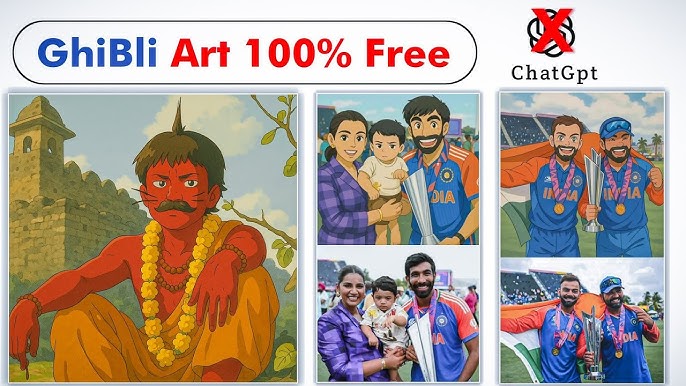Studio Ghibli art is recognizable for its breathtaking visuals, emotional undertones, and profound detail. Founded by the legendary filmmakers Hayao Miyazaki and Isao Takahata, Studio Ghibli has captured the hearts of people all over the world through its brilliant animation that combines elaborate fantasy with deep, intricate human emotions. Every single film is visually exquisite, allowing the audience to experience and delve into imaginative worlds filled with enchantment, nostalgia, and much more.
The Distinctive Style of Studio Ghibli Art
The studio ghibli art stands out due to distinctive elements such as hand-drawn animation, rich color palette, and fluidity of movement. While a big number of modern studios heavily rely on digital effects, Ghibli focuses on traditional cel animation, which makes the studio’s films ageless. Each and every frame is overflowing with beauty and life. Accomplished brushstrokes, subtle lighting, exquisite color blending, and deep magical undertones combine to create an immersive atmosphere with immense stillness entwined.
Ghibli’s Attention to Themes of Detail and Nature
In every Ghibli Studio film, there is always a theme of nature. In “My Neighbor Totoro,” and “Mononoke Hime,” there is a repetative display of exuberant landscapes and forests that the studio attempts to, or rather, does love and encourage. Every movement of water, rustling of leaves, and sunlight being animated demonstrates the care put into achieving ‘realism’ in these fantasy worlds. A clear display of Ghibli’s love for nature involve the stories’ portrayal of humans, their worlds in direct collision with nature and the industrialized earth.
Characters in Studio Ghibli films highly resemble reality, and they take unique forms in each movie to further express their creative touch. Every character’s face is animated portraying a range of expressions one is highly likely to experience in reality. The same can be said for Chihiro’s exaggerated ‘shy-girl’ persona evolved into a ‘brave-girl’ persona in the film ‘Spirited Away,’ or Ashitaka’s inner monologues in ‘Princess Mononoke.’ Even imaginative beings like Catbus and No-Face feature through expressions and movements brimming with sentiment and personality.
The Function of Architecture in Relation to Daily Life Activities
Ghibli’s artwork frequently combines fantastical aspects with realistic locations. Masterful architecture is present in the cozy homes of Kiki’s Delivery Service, the European towns in Howl’s Moving Castle, as well as the magical bathhouse in Spirited Away. Every detail from cityscapes to food to interiors is animated and makes everyday life feel real and authentic. The exquisite cooking sequences, especially the breakfast in Howl’s Moving Castle and the bento lunch in My Neighbor Totoro, showcase beauty in the mundanity of daily life, which makes these scenes unforgettable.
Visually Communicating Emotions
Ghibli clips posses stunning beauty, but Studio Ghibli art has undoubtedly been a defining factor in expressing the story. Different colors represent various moods. Warm tones for comforting scenes, whilst darker hues are used during more tense moments. Visual details such as a breeze through the open window or a flickering lantern brings emotion without words being uttered. The Depth of emotions that can be brought forth using visual imagery is a Ghibli hallmark. The manner in which light beams through trees and the way shadows cast on people, as well as the steam rising from a ramen bowl, add to the weight of emotion in each scene.
Impact of Japanese Culture on Folklore
The art of Studio Ghibli has deep ties to Japan, incorporating themes from folklore, Shinto, and history. Countless references to Japanese mythology is present in Spirited Away and Kaguya-hime no Monogatari is an adaptation of one ancient Japanese folktale. Ghibli’s films feature spiritual elements which expresses reverence for nature and spirits. These films are marked by a modern narrative intertwining with classical elements, making the film distinctly Japanese yet appealing internationally.
The Impact and Legacy of Studio Ghibli Art
Studio Ghibli art is cherished by numerous animators and artists across the globe. In modern films, video games, and even fashion, traces of Ghibli’s influence can be found. The studio is renowned for its hand-drawn animation which sets a benchmark in the industry; traditional animation is just as powerful now more than ever. Many animation studios, japanese and international alike, attempt to capture the beauty and depth of Ghibli’s work, but few manage to capture the same magic.
Conclusion
The wonderful worlds within Studio Ghibli creations stem from the unique hand-crafted animations and nature-oriented settings, in addition to the emotional stories associated with each piece. The magic woven throughout a Studio Ghibli film remains unparalleled in the realm of cinema and captivates people of all ages. Each new film release further demonstrates their impact on the world of art and animation.
Read about Studio Ghibli Artwork more here.
Follow Media Linx for more article like this and be updated to all latest news and trend!
